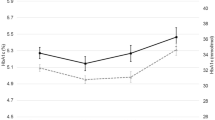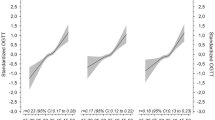Abstract
Background/Aims: The use of glycated hemoglobin (HbA1c) measurement in gestational diabetes mellitus (GDM) is controversial. Aim of the present study was to determine HbA1c levels in a series of GDM patients, in order to verify the possible contribution of HbA1c to GDM management. Materials/Subjects and methods: The study included 148 caucasian GDM patients. GDM screening was performed between the 24th and the 28th week of gestation by a two-step procedure, according to the 4th and 5th International Workshop Conference on Gestational Diabetes Mellitus recommendations. Exclusion criteria were: preexisting diabetes, corticosteroid therapy, history of asthma or hypertension, known fetal anomaly, history of previous stillbirth, preterm delivery considered to be likely for either maternal disease or fetal conditions. HBA1c was determined by a standard HPLC technique. Results: At GDM diagnosis, all HbA1c levels were ≤6% and the greatest frequency (71/148; 48.0%) of HbA1c values resulted in the range 5.0–5.3%. This frequency increased to 54% before delivery. A significant correlation between HbA1c values at GDM diagnosis and individual BMI prior to conception was observed. The proportion of pregnancies presenting negative outcomes increased progressively with increasing HbA1c levels, from 6.2% (1/16) for HbA1c levels <5% to 18.3% (13/71) for HbA1c 5.0–5.3%, to 37.8% (17/45) in patients with HBA1c levels 5.4–5.6%, to 56.2% (9/16) for HbA1c levels >5.6%. ROC analysis showed that HbA1c at diagnosis and before delivery resulted a good predictor of adverse pregnancy outcome. Conclusions: The present results indicate that HbA1c levels could be of help in predicting adverse pregnancy events.
Similar content being viewed by others
References
Metzger BE, Coustan DR. Summary and recommendations of the Fourth International Workshop-Conference on Gestational Diabetes Mellitus. The Organizing Committee. Diabetes Care 1998, 21(Suppl 2): B161–7.
Langer O, Yogev Y, Most O, Xenakis EM. Gestational diabetes: The consequences of not treating. Am J Obstet Gynecol 2005, 192: 989–97.
WHO consultation. Definition, diagnosis, and classification of diabetes mellitus and its complications. Report of a WHO consultation. Part 1: diagnosis and classification of diabetes mellitus. WHO/NCD/NCS/99.2. Geneva: World Health Consultation, 1999.
American Diabetes Association. Gestational Diabetes Mellitus. Diabetes Care 2003, 26(Suppl 1): S103–5.
Metzger BE, Buchanan TA, Coustan DR, et al. Summary and recommendations of the Fifth International Workshop-Conference on Gestational Diabetes Mellitus. Diabetes Care 2007, 30(Suppl 2): S251–60.
The HAPO Study Cooperative Research Group; Metzger BE, Lowe LP, Dyer AR, et al. Hyperglycemia and adverse pregnancy outcomes. N Engl J Med 2008, 358: 1991–2002.
Metzger BE, Gabbe SG, Persson B, et al. International Association of Diabetes and Pregnancy Study Groups Recommendations on the Diagnosis and Classification of Hyperglycemia in Pregnancy. Diabetes Care 2010, 33: 676–82.
American Diabetes Association. Standards of Medical Care in Diabetes-2011. Diabetes Care 2011, 34(Suppl 1): S11–61.
Screening and diagnosis of Gestational Diabetes Mellitus. ACOG Committee Opinion N∘ 504. The American College of Obstetricians and Gynecologists. Obstet Gynecol 2011, 118: 751–3.
The effect of intensive treatment of diabetes on the development and progression of long-term complications in insulin-dependent diabetes mellitus. The Diabetes Control and Complications Trial Research Group. N Engl J Med 1993, 329: 977–86.
Intensive blood-glucose control with sulphonylureas or insulin compared with conventional treatment and risk of complications in patients with type 2 diabetes (UKPDS 33). UK Prospective Diabetes Study (UKPDS) Group. Lancet 1998, 352: 837–53.
Handelsman Y, Mechanick JI, Blonde L, et al. American Association of Clinical Endocrinologists. Medical Guidelines for Clinical Practice for Developing a Diabetes Mellitus Comprehensive Care Plan. Endocr Pract 2011, 17(Suppl 2): 1–53.
Kitzmiller JL, Block JM, Brown FM, et al. Managing preexisting diabetes for pregnancy. Diabetes Care 2008, 31: 1060–79.
Hone J, Jovanovic L. Approach to the patient with diabetes during pregnancy. J Clin Endocrinol Metab 2010, 95: 3578–85.
Mosca A, Paleari R, Dalfrà MG, et al. Reference intervals for hemoglobin A1c in pregnant women: Data from an Italian Multicenter Study. Clin Chem 2006, 52: 1138–43.
Balaji V, Madhuri BS, Ashalatha S, Sheela S, Suresh B, Seshiah V. A1C in gestational diabetes mellitus in Asian Indian women. Diabetes Care 2007, 30: 1865–7.
Lowe LP, Metzger BE, Dyer AR, et al. Hyperglycemia and Adverse Pregnancy Outcome (HAPO) Study. Associations of maternal A1C and glucose with pregnancy outcomes. Diabetes Care 2012, 35: 574–80.
The American College of Obstetricians and Gynecologists. Ultrasonography in pregnancy. ACOG Practice Bulletin n∘ 101. Obstet Gynecol 2009, 113: 451–61.
Mancia G, De Backer G, Dominiczak A, et al. 2007 Guidelines for the management of arterial hypertension. Eur Heart J 2007, 28: 1462–536.
World Health Organization. Neonatal and perinatal mortality: country, regional and global estimates. Geneva: World Health Organization, 2006.
The American College of Obstetricians and Gynecologists. Fetal Macrosomia. ACOG Practice Bulletin n∘ 22, November 2000.
Schwartz R, Teramo KA. What is the significance of macrosomia? Diabetes Care 1999, 22: 1201–5.
Intrauterine growth restriction. The American College of Obstetricians and Gynecologists. ACOG Practice Bulletin n∘ 12, January 2000.
Cornblath M, Hawdon JM, Williams AF, et al. Controversies regarding definition of neonatal hypoglycemia: suggested operational thresholds. Pediatrics 2000, 105: 1141–5.
Dennery PA, Seidman DS, Stevenson DK. Neonatal Hyperbilirubinemia. N Engl J Med 2001, 344: 581–90.
Mimouni F, Tsang RC. Neonatal hypocalcemia: to treat or no to treat? J Am Coll Nutr 1994, 13: 408–15.
Werner EJ. Neonatal polycythemia and hyperviscosity. Clin Perinatol 1995, 22: 693–710.
Rodriguez RJ. Management of respiratory distress syndrome: An update. Respir Care 2003, 48: 279–86.
Avery ME, Gatewood OB, Brumley G. Transient tachypnea of newborn. Possible delayed resorption of fluid at birth. Am J Dis Child 1966, 111: 380–5.
Nathan DM, Turgeon H, Regan S. Relationship between glycated haemoglobin levels and mean glucose levels over time. Diabetologia 2007, 50: 2239–44.
Nielsen LR, Ekbom P, Damm P, et al. HbA1c levels are significantly lower in early and late pregnancy. Diabetes Care 2004, 27: 1200–1.
Crowther CA, Hiller JE, Moss JR, et al. Effect of treatment of gestational diabetes mellitus on pregnancy outcomes. N Engl J Med 2005, 352: 2477–86.
Landon MB, Spong CY, Thom E, et al. A multicenter, randomized trial of treatment for mild gestational diabetes. N Engl J Med 2009, 361: 1339–48.
The HAPO Study Cooperative Research Group. Hyperglycaemia and Adverse Pregnancy Outcome (HAPO) Study: associations with maternal body mass index. BJOG 2010, 117: 575–84.
Ricart W, Lopez J, Mozas J, et al. Body mass index has a greater impact on pregnancy outcomes than gestational hyperglycaemia. Diabetologia 2005, 48: 1736–42.
Author information
Authors and Affiliations
Corresponding author
Additional information
These authors equally contributed to the study and both may claim last authorship.
Rights and permissions
About this article
Cite this article
Capula, C., Mazza, T., Vero, R. et al. HbA1c levels in patients with gestational diabetes mellitus: Relationship with pre-pregnancy BMI and pregnancy outcome. J Endocrinol Invest 36, 1038–1045 (2013). https://doi.org/10.3275/9037
Accepted:
Published:
Issue Date:
DOI: https://doi.org/10.3275/9037




